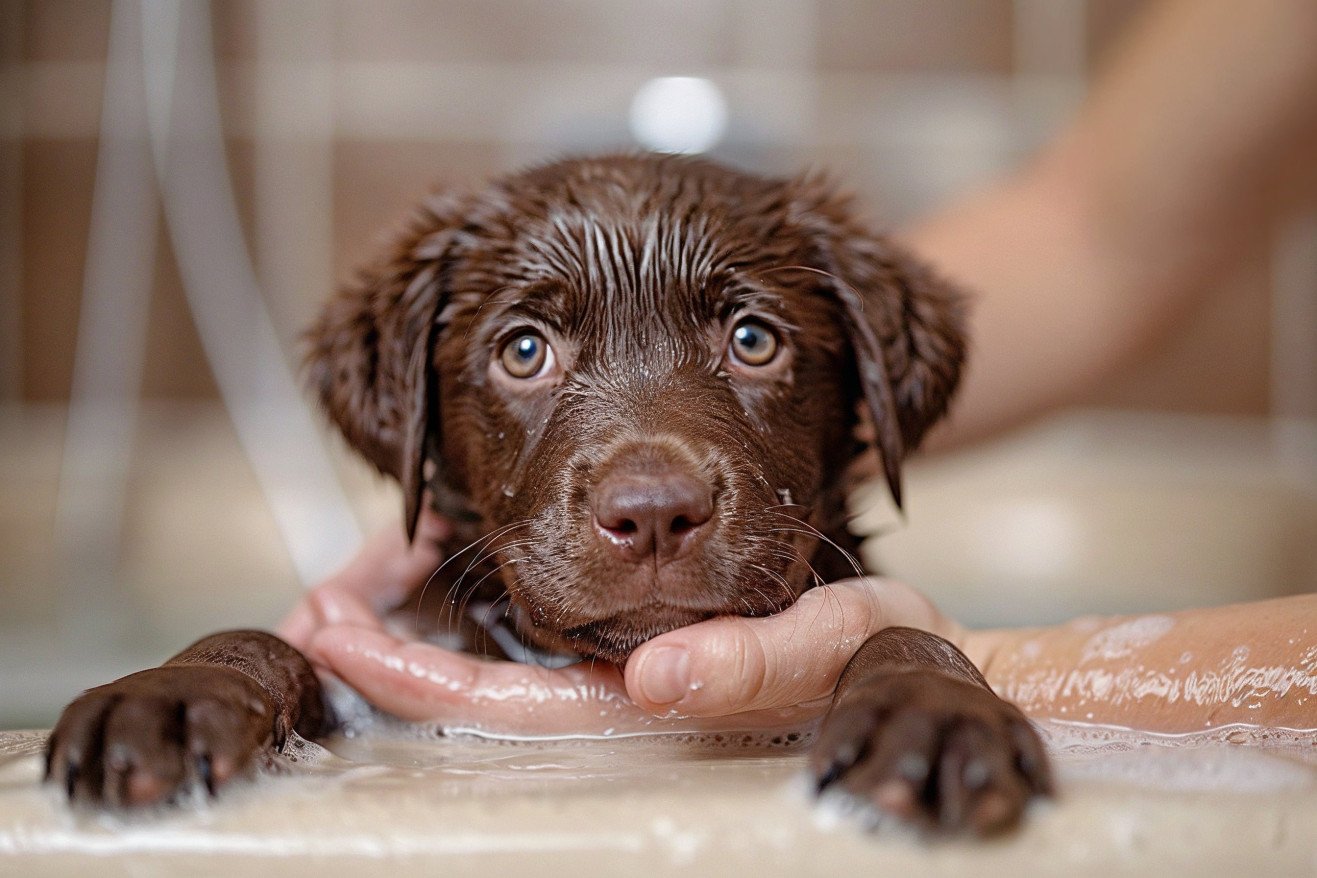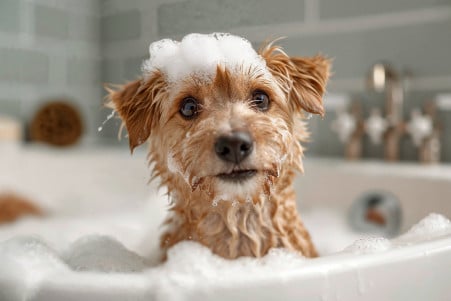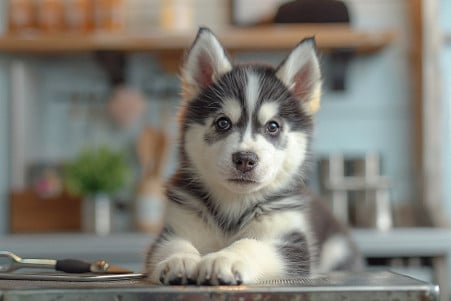How to Bathe a 2 Week Old Puppy: A Step-by-Step Guide
25 April 2024 • Updated 23 April 2024

If you’ve recently brought home a new puppy, you may be wondering if it’s OK to give your furry friend a bath. While there are many factors to consider when it comes to bathing puppies under 4 weeks old, the short answer is no, you should not bathe a 2 week old puppy. Puppies are unable to regulate their body temperature until they are 4 weeks old, so it’s best to wait until they reach this milestone before giving them a bath.
In this article, we’ll explore the latest findings from veterinarians, animal behaviorists, and dog breeders and trainers to help you better understand the safest ways to bathe puppies at different ages. By learning from these experts, you’ll be better equipped to bathe your puppy at the right time and in the right way, while minimizing the risk of any health or behavioral issues. This way, you can make sure your puppy is healthy and happy during their first few weeks in their new home.
Can you give a 2 week old puppy a bath?
How to Tell If a Puppy Needs a Bath and How Often to Bathe Them
Puppies should be bathed every 4-6 weeks to remove dirt, oils, and odors that have accumulated, says the American Kennel Club. However, if your puppy is especially active or spends a lot of time outside, you may need to bathe them more often. Signs that a puppy needs a bath include a coat that looks and feels dirty, greasy, or matted, visible dirt or debris, and a bad smell.
It's important not to bathe puppies too often, as bathing too frequently can remove the oils that protect their skin and coat. Puppies under 8 weeks old should only be spot cleaned with a damp cloth as needed, as they can't regulate their body temperature yet. From 8 weeks to 6 months old, it's generally recommended to bathe puppies once a month using a shampoo made for puppies to keep their developing coats clean without drying out their sensitive skin.
How often you should bathe your puppy depends on their coat type and length, how active they are, and how old they are. For example, puppies with long hair may need to be bathed more often to prevent their hair from matting, while puppies with short hair may be able to go longer between baths. In general, it's best to develop a regular grooming schedule that's based on your puppy's individual needs to help ensure their skin and coat stay healthy.
How to Get Ready for a Puppy’s First Bath
Getting ready for a puppy’s first bath involves getting the right supplies and setting up the right environment. According to 12 Dog Training Tips to Make Your Pup Love Bathing by AlphaPaws, the bathing area should be a smaller, enclosed area like a bathroom or kitchen. This will help keep the puppy from getting distracted and make them feel more secure.
It’s also important to make sure the water is the right temperature, between 85-95°F, because as Why Do Dogs Hate Baths? (& How to Bathe a Scared Dog) on Hill's Pet explains, dogs are more sensitive to temperature than humans. Having someone there to gently hold the puppy or using a tub that the puppy can’t escape from can also help make the bath less stressful.
To help the puppy feel more comfortable, My Dog Hates the Bath: 8 Steps to Bathing Your Scared Dog on Rover.com suggests that you get the puppy used to the bathing area by using positive reinforcement and treats. This way, the puppy will have positive associations with bath time.
By making sure you have everything you need and taking a calm, patient approach, you can help make sure that the puppy’s first bath goes as smoothly as possible.
How to Bathe a Puppy
When you bathe your puppy, you should use a gentle water source or a cup to wet your puppy's fur, making sure to avoid the face and ears, according to the American Kennel Club. Then, use a small amount of puppy shampoo, and make sure to work it into a light lather and massage it into the skin. Make sure to rinse thoroughly to avoid skin irritation and matting, according to Purina.
The face and ears can be cleaned with a damp washcloth or cotton balls, but make sure to be gentle and avoid causing irritation. Make sure to give your puppy treats and praise throughout the process to ensure that it's a positive experience, according to Orvis News, and make sure to continue to do this so that your puppy learns to enjoy bath time.
How to Dry and Keep a Puppy Warm After a Bath
Once you've bathed your puppy, it's important to dry them properly to avoid chills and other issues. According to 4 Methods For Drying Your Dog After A Bath by Dog Lover's Towel, the first step is to use absorbent towels to pat and gently squeeze the water out of the puppy's fur. If you want to speed up the process, you can also use a dog-safe hairdryer set to a low, cool setting, but make sure to keep the dryer moving and watch out for overheating.
While you're drying the puppy, How to Dry Your Dog After a Bath: 5 Effective Steps by Dogster suggests brushing the puppy's fur to prevent matting and remove any loose hair. Once the puppy is mostly dry, make sure to give them a warm, draft-free environment with soft bedding to finish drying, according to Gentle Ways to Keep Your Dog Warm and Comfortable After a Bath by Doggyzine.com. Make sure to keep a close eye on the puppy to make sure they don't get too cold during this time, as Dog shivering after bath? What you can do to help by PetsRadar points out.
By making sure to dry and keep the puppy warm after a bath, you can help ensure that they don't experience any discomfort or health problems, and you can also help make sure that they have a positive experience that will help them get used to the grooming process.
Building Healthy Grooming Routines in Puppies
Building healthy grooming routines in puppies is important from a young age. As explained in Puppy Grooming: Easy Tips for Doing It Yourself? by Zigzag, puppy grooming includes brushing and bathing to keep their skin and coat clean, and it's also important to take care of their nails and teeth. The article suggests that you start to introduce grooming tasks like brushing and nail clipping early and slowly with positive reinforcement.
7 Essential Puppy Grooming Tips by Trupanion stresses that you should keep grooming sessions short and always end on a positive note to help your puppy build confidence. Meanwhile, Puppy Grooming 101: Tips for Grooming Your New Puppy by The Wildest explains that working with a professional groomer can help you make sure that you're introducing puppies to the full grooming process in a way that makes them comfortable.
As explained in Dog Grooming: First-Time Owner's Guide To Pet Grooming by PetBar, sticking to a regular grooming schedule will help puppies get used to the process. Regular grooming from an early age will also help ensure that puppies have healthy coats, skin, nails, teeth, and ears, which will help ensure their overall health.
Conclusion: How to Keep Your Puppy Safe and Comfortable During Bath Time
Bathing puppies younger than 4 weeks old is not recommended due to the potential risks involved. According to veterinary professionals, puppies younger than 4 weeks old have an immature thermoregulatory system, which can make bathing unsafe and even life-threatening.
That said, once puppies reach 4-8 weeks old, they can be introduced to gentle baths using puppy-safe products. The American Kennel Club suggests using a warm washcloth or damp cotton balls to gently wipe down puppies in this age range, but you should avoid using soap or shampoo.
It's important to make sure that you're setting your puppy up for success by preparing them for bath time and using positive reinforcement. Gradually introducing puppies to the bathing area, ensuring that the water is at a comfortable temperature, and offering treats and praise can help puppies feel more confident and comfortable during bath time.
Making sure that you dry your puppy properly, keep them warm, and monitor them closely after their bath is also important to make sure that they don't get too cold or stressed. Drying your puppy's coat thoroughly and providing a warm, draft-free space for them to dry completely can help ensure that they stay comfortable and safe.
Getting your puppy used to good grooming practices early in life can help support their health and well-being. Regular brushing, nail trims, and gentle baths can help ensure that your puppy has a healthy coat, skin, and hygiene, and can help set them up for a lifetime of positive grooming experiences.


